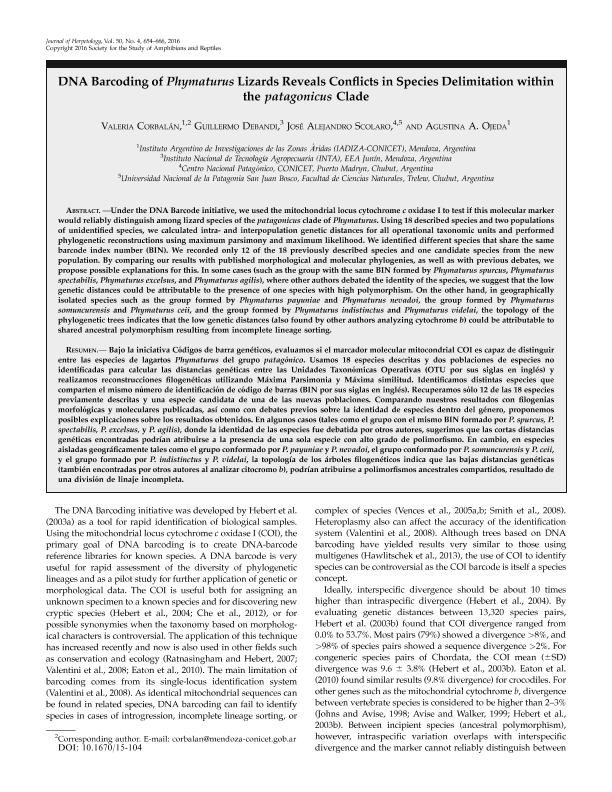Artículo
DNA barcoding of Phymaturus lizards reveals conflicts in species delimitation within the patagonicus clade
Corbalán, Valeria Elizabeth ; Debandi, Guillermo; Scolaro, Jose Alejandro
; Debandi, Guillermo; Scolaro, Jose Alejandro ; Ojeda, Agustina Alejandra
; Ojeda, Agustina Alejandra
 ; Debandi, Guillermo; Scolaro, Jose Alejandro
; Debandi, Guillermo; Scolaro, Jose Alejandro ; Ojeda, Agustina Alejandra
; Ojeda, Agustina Alejandra
Fecha de publicación:
12/2016
Editorial:
Society for the Study of Amphibians and Reptiles
Revista:
Journal of Herpetology
ISSN:
0022-1511
Idioma:
Inglés
Tipo de recurso:
Artículo publicado
Clasificación temática:
Resumen
Under the DNA Barcode initiative, we used the mitochondrial locus cytochrome c oxidase I (COI) to test if this molecular marker would reliably distinguish among lizard species of the patagonicus clade of Phymaturus. Using 18 described species and two populations of unidenfied species, we calculated intra- and inter-population genetic distances for all operational taxonomic units (OTU) and performed phylogenetic reconstructions using maximum parsimony and maximum likelihood. We identified different species that share the same barcode index number (BIN). Only 12 of the 18 previously described species were recovered, and one candidate species from the new population. By comparing our results with published morphological and molecular phylogenies as well as previous debates, we propose possible explanations for this. In some cases (such as the group with the same BIN formed by P. spurcus, P. spectabilis, P. excelsus, and P. agilis), where the identity of the species was previously debated by other authors, we suggest that the low genetic distances could be attributable to the presence of one species with high polymorphism. On the other hand, in geographically-isolated species such as the group formed by P. payuniae and P. nevadoi, the group formed by P. somuncurensis and P. ceii, and the group formed by P. indistinctus and P. videlai, the topology of the phylogenetic trees indicates that the low genetic distances (also found by other authors analyzing cytochrome b) could be attributable to shared ancestral polymorphism resulting from incomplete lineage sorting.
Palabras clave:
Coi
,
Liolaemidae
,
Patagonia
,
Polymorphism
,
Systematic
Archivos asociados
Licencia
Identificadores
Colecciones
Articulos(IADIZA)
Articulos de INST. ARG DE INVEST. DE LAS ZONAS ARIDAS
Articulos de INST. ARG DE INVEST. DE LAS ZONAS ARIDAS
Citación
Corbalán, Valeria Elizabeth; Debandi, Guillermo; Scolaro, Jose Alejandro; Ojeda, Agustina Alejandra; DNA barcoding of Phymaturus lizards reveals conflicts in species delimitation within the patagonicus clade; Society for the Study of Amphibians and Reptiles; Journal of Herpetology; 50; 4; 12-2016; 654-666
Compartir
Altmétricas



